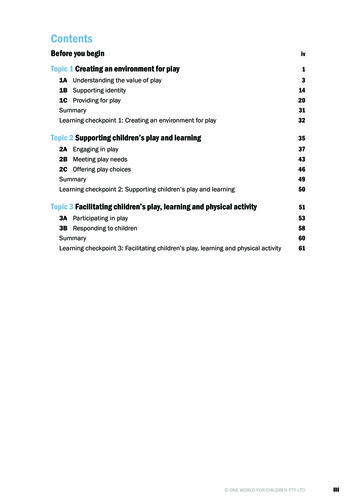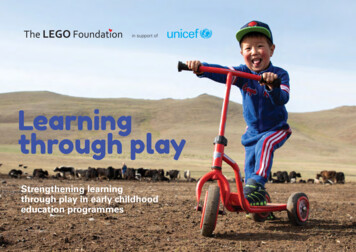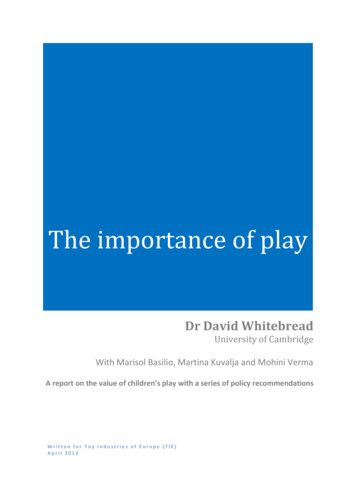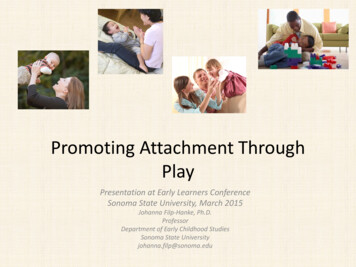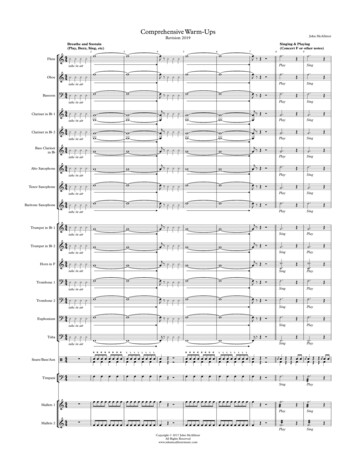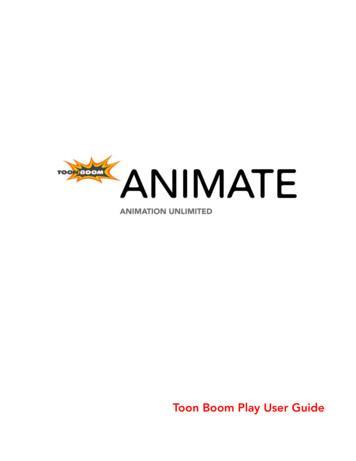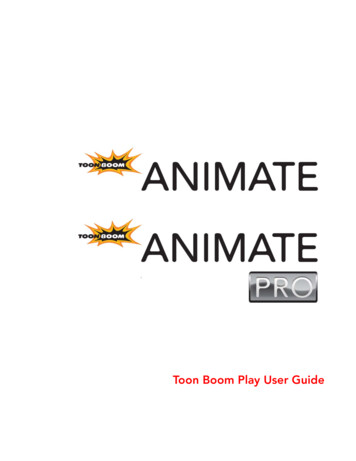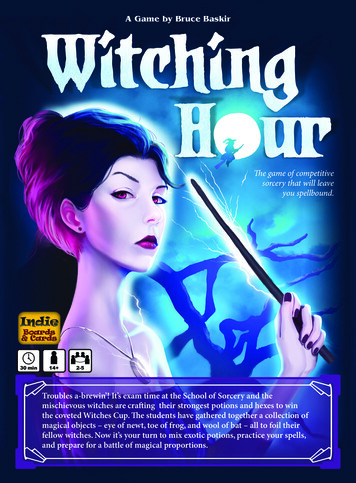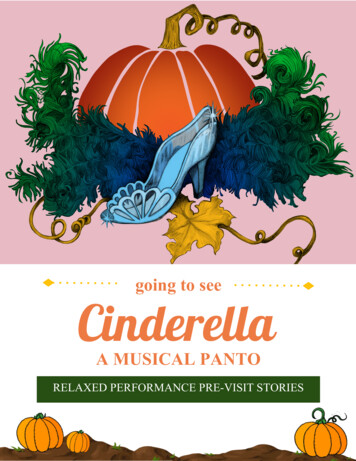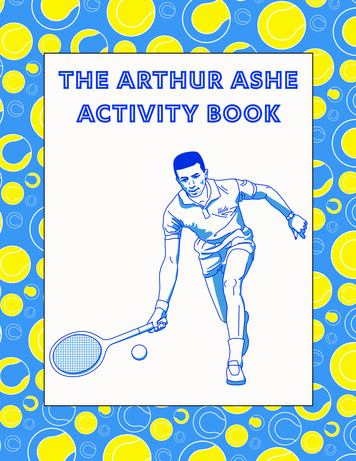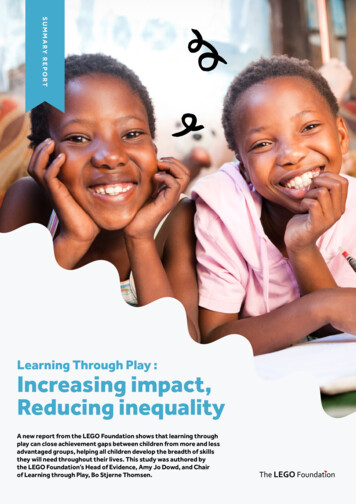
Transcription
S U M M A RY R E P O RTLearning Through Play :Increasing impact,Reducing inequalityA new report from the LEGO Foundation shows that learning throughplay can close achievement gaps between children from more and lessadvantaged groups, helping all children develop the breadth of skillsthey will need throughout their lives. This study was authored bythe LEGO Foundation’s Head of Evidence, Amy Jo Dowd, and Chairof Learning through Play, Bo Stjerne Thomsen.
01020304Summaryp.3Learning through play:an effective way to closeachievement gapsp.4The findingsp.11Conclusions andrecommendationsp.16Table ofcontentsSummary of full research report and full research reportavailable on: educing-inequality/T H E L EG O FOU N DATIONI N C R E ASI N G I M PAC T, R E D U C I N G I N EQ UA L IT Y2
0102030401.SummaryA new report from the LEGOFoundation shows thatlearning through play can closeachievement gaps betweenchildren aged 3-6 years, frommore and less advantagedgroups, helping all childrenin pre-school develop thebreadth of skills they will needthroughout their lives.Many pre-school education programmes target childrenfrom disadvantaged groups, focusing only on academicoutcomes in early childhood, with the aim of teachingyoung children the basic academic skills of school readiness.But a new report published by the LEGO Foundation provides initial evidence of the power of learning throughplay to tackle inequality and improve the outcomes ofchildren from different socio-economic groups.Learning through play may represent the best long-termvalue for helping children, regardless of background, todevelop a breadth of skills that will last.Here are some key points:The power oflearning through playClosing thelearning gapPlay for all-rounddevelopmentPolicymakers and international organisations need tostart taking play seriously,as a way of helping childrenlearn, supporting inclusionand reducing inequality.A greater focus onlearning through play inearly childhood couldbe an effective strategy forclosing achievement gapsbetween disadvantagedchildren and their moreadvantaged counterparts.Studies from around theworld show that free andguided play and their facilitation help children developthe breadth of skills theyneed. Not just ABCs and123s, but also self control,cooperation, and creativity.T H E L EG O FOU N DATIONWhat works bestEvidence suggests that playthat enables children tomake their own choices,that allows them activelyto test out ideas, and thatgives them enjoyment, isalso what works best inclosing achievement gaps.I N C R E ASI N G I M PAC T, R E D U C I N G I N EQ UA L IT Y3
0102030402.Learning Through Play:an effective way to closeachievement gapsIn recent years, the benefits of learning through play, especially for early brain development, have been increasinglyrecognised. But many prestigious international organisationsstill do not recognise play in their statements of educationquality. They need to do so.There is also a lingering perception among teachers andparents of play as being separate from learning: as being opposed to the seriousness of school and work.The power of learning through play needs to be morewidely recognised. The new report Learning through play:increasing impact, reducing inequality (authored by theLEGO Foundation’s Head of Evidence, Amy Jo Dowd, andChair of Learning through Play, Bo Stjerne Thomsen) gathersevidence, for the first time, from the studies that have beencarried out on early childhood programme impact aroundthe world over the last decade.There is growing evidencethat learning through playcan help close achievementgaps between advantagedand disadvantaged children,especially at scale andin environments whereresources are limited.The report shows that learning through play in pre-schoolsettings helps children in very different countries to develop holistic skills that will serve them throughout their lives.There is some evidence that it helps to close achievementgaps, in particular.Most of the interventions that close achievement gapsinclude free play and play guided by adults but led by children.The studies show that these types of play can be supportedeven where resources are constrained.The interventions that help to close achievement gaps notonly enable children to make their own choices, but alsoallow them to try things out and test ideas, and they givechildren enjoyment.Finally, the studies show that different types of play can promote learning in different settings.T H E L EG O FOU N DATIONI N C R E ASI N G I M PAC T, R E D U C I N G I N EQ UA L IT Y4
01020304The report ends by highlightingareas where greater focus andinvestment could pay off: Building up a better understanding of how free andguided play in particular can close achievement gaps,especially in resource-constrained contexts. Testing approaches for increasing learning throughplay in early childhood interventions. Carrying out longitudinal studies of learning throughplay in early childhood, and its long-term effect onchildren’s development. Applying the lens of learning through play in studiesof primary education.H E L EG O FOU N DATIONT HEE N ,T,TECHUNCOLOGYANUAD PLAYI N C R E ASICNHGI LI DMRPACREDI N G I N EQL ITY5
0102Why is the LEGO Foundationinvolved in research onchildren’s play?The LEGO Foundation supports learning through play,aiming to empower children to become creative, engaged,lifelong learners, and to develop a breadth of skills thatwill serve them, their communities and society as a whole,through a lifetime.In order to reach children systematically with learningthrough play, the LEGO Foundation has long supportedresearch on children’s play and learning. This furthers ourunderstanding of the enormous power of play to supportlearning in homes and classrooms.Learning through play involves children learning deeply,leading to them gaining a wide range of skills and subjectknowledge, and helping them to thrive as individuals whilealso contributing positively to the societies they live in.Why focus on play and equality?According to UNICEF, early childhood presents an “exceptionally powerful opportunity to break inter-generationalcycles of inequity.”0304Inequality in learning is an urgent issue, severely impactingon individual children’s life chances, and economies and societies around the world.There is growing evidence that learning through play maypresent a solution to this problem of inequality. Many studiesdemonstrate the benefits of learning through play, especiallyfor early brain development – these include social, emotional,cognitive and physical benefits. Yet the value and potential oflearning through play is still not recognised widely enough.Play is absent from many international statements of educationquality, as well as from reviewsof the impact of early childhoodprogrammes that have beenpublished by economists anddevelopmental psychologists,who often focus on quality in earlychildhood programmes, but noton play.Yet inequality starts to show itself early in education.Across 64 countries, the richest children are seven timesmore likely to attend pre-school programmes than thepoorest (UNICEF). And even when they do attend preschool programmes, learning gaps persist between olderchildren from less advantaged groups and their moreadvantaged peers.These disadvantages are based on :SexRacePovertyDisabilityT HE L EG O FOU N DATIONGeographyEthnicityLanguageI N C R E AS I N G I M PAC T, R E D U C I N G I N EQUA L IT Y6
0102A global review of recentresearchThe LEGO Foundation’s new report Learning through play:increasing impact, reducing inequality looks at recent evidence from around the world relating to early childhoodlearning programmes. It shows the potential of children’splay to improve learning outcomes, and to close the achievement gap that exists between children from more and lessadvantaged groups.The study broadens the scope of previous studies of play’simportance for learning, which have tended to be small studies carried out in developed countries. It looks at evidencefrom around the world (including both developed and developing countries) regarding play, learning and inequality.Approaches to researchThe report analyses recent research studies on pre-schoollearning programmes around the world, considering theirdifferent approaches to learning through play. This includesthe different ways in which learning through play can befacilitated.The report draws on evidence from 26 studies of earlychildhood learning programmes, carried out in 18 locationsaround the globe, as well as interviews with the authors ofT H E L EG O FOU N DATION0304these studies. The interventions that were studied vary infocus and intensity, but they all involved moving early childhood education towards incorporating learning through play.MacroThe evidence that is presented is mostly at the macro scale(across schools and learning programmes, including at thenational level), showing the power of learning through play inrealising the potential of all children, and specifically in closing achievement gaps.MicroBut it also looks at the micro level (individual classrooms)– where there is some evidence that learning through playcan be used as a way of increasing inclusion, with the aim ofcreating a more egalitarian society.OverallOverall, the report presents evidence that learning throughplay can help address inequalities in outcomes between children with different levels of access to learning opportunities– inequalities that exist both within and between countries.By increasing awareness among policymakers of the potential of play for improving learning and closing achievementgaps, the report enables them to make more informed decisions regarding investment in early childhood.I N C R E ASI N G I M PAC T, R E D U C I N G I N EQ UA L IT Y7
0102030418 ambiqueIndonesiaSouth AfricaAustralia26 studies* Map not to scaleTHE L EG O FOU N DATIONI N C R E AS I N G I M PAC T, R E D U C I N G I N EQUA L IT Y8
01020304What is learning through play?The report draws on previous research supported by theLEGO Foundation, on the benefits of learning through play.The LEGO Foundation and its research partners have identified five key characteristics of learning through play.For children, the experience of learning through play is:Joyful, even if it is challenging. Meaningful, by connecting to children’s livesand past experiences. Engaged, involving active, ‘minds-on’ thinking. Iterative, allowing children to test ideasand try things out. Social, involving interaction and collaborationwith others.When these elements are strongly present in play, deeplearning is the result: learning that stays with children andgives them the skills and knowledge that they can apply toreal-life situations.Types of playThe report describes how play activities fall into fivemain types :Physical playPretend playObject play (involving physical materials)Symbolic playGames with rulesWhile there is naturally some degree of overlap betweenthem, the authors note that these types of play were seenwith very different degrees of frequency and intensity inthe early learning programmes that were researched.T H E L EG O FOU N DATIONTypes of play frequently overlap.As one study author noted: Thecomplexity of play is such that youhave pretend play superimposedover the others when you haveplay in a park, the main activityis jumping around with a ball, butthere are roles and parts in a battle. It isn’t just physical play. Goodplayers make pretend play out ofthe other types Pretend play isthinking play.I N C R E ASI N G I M PAC T, R E D U C I N G I N EQ UA L IT Y9
010203The spectrum of strategiesfor facilitating learningthrough playAs well as the types of play involved, there is also considerable variation in the approaches used in early childhoodeducation programmes, to support and facilitate children’slearning through play.FreeThese approaches can be seen as representing differentpoints on a spectrum or continuum, in terms of the amountof adult intervention that they involve. They range fromstructured, teacher-led approaches at one end of the spectrum, in which games are used didactically, to guided and freeplay at the other, in which children have much more initiative,and where the adults define the outcomes and provide relevant resources (in the case of guided play), but children findtheir own solutions and are encouraged to reflect on play.Guided PlayChild Choice04GamesInstructionsBalanceStructureFigure 1. The spectrum of classroom facilitation strategiesAn example of guided play :Tools of the MindGuided play can involve adults providing guidance and reflection, but allowing the children to decide on the approach theywill adopt. This approach can be seen in the Tools of theMind intervention in Canada and the US, in which teachershelp children to dramatise The Magic Treehouse books, supporting them in planning their play, creating their props andshaping their roles.THE L EG O FOU N DATIONChildren involved in Tools of the Mind : Have been shown to have greater reading and writing skills, self-control, attention regulation and joyin education than their peers in other early childhoodsettings; They also experience lower levels of exclusion and theintervention has also been shown to close achievementgaps between students from advantaged and disadvantaged groups.I N C R E AS I N G I M PAC T, R E D U C I N G I N EQUA L IT Y10
01020303.The findings041%3% 1%24%%1318%18%The report shows that supporting learning through play in earlychildhood education can indeed be an effective strategy forclosing achievement gaps between children aged three to six.In all 18 countries, the studies show the impact of interventionsinvolving learning through play on child development, includingon the development of children in disadvantaged groups. Seveninterventions were seen to close achievement gaps. Acrossthese studies, the domains investigated differ (see Figure), as dothose on which the intervention had an impact.Interventions that include more free play and guided play wereshown to be more likely to demonstrate all five characteristicsof learning through play. They also appear more likely to closeachievement gaps.There are initial suggestions, across different countries, of theimportance of child choice in leading, changing and contributingto play.23%Language and literacyMotorCognitivePhysicalMathsStress responseSocial EmotionalCreativityFigure 2. Domains of child development included inintervention studiesFour factors emerge as importantin early childhood The amount and type ofThe amount and type ofHow much interventionsHow much they engageteacher training implemented.follow-up teacher supportinvolve the provision of materi-parents (few currently do).that is provided.als (books, toys, etc.) & activities (singing, storytelling, etc.)T H E L EG O FOU N DATIONI N C R E ASI N G I M PAC T, R E D U C I N G I N EQ UA L IT Y11
01020304Examples from aroundthe world show thateven in resourceconstrained settings,free and guided playare possible.Interventions at scale indisadvantaged communities:Save the Children’s programmes inBangladesh, Rwanda and EthiopiaInterventions in Bangladesh, Rwanda and Ethiopia used a mixof instruction as well as free and guided play, and took placeacross dozens if not hundreds of early childhood centres indisadvantaged communities.T H E L EG O FOU N DATIONStudies of these interventions show significantly greaterlearning gains for children in terms of their literacy, numeracy, motor and social-emotional development, comparedto children in traditional early childhood centres, and theclosing of achievement gaps between children of differentsocio-economic status.These and other examples from around the world show thateven in resource-constrained settings, free and guided playare possible.I N C R E ASI N G I M PAC T, R E D U C I N G I N EQ UA L IT Y12
01020304Key findings01 - The importance ofsupport for teachers.It is not easy for teachers to make the transition to approaches involving learning through play: the studies showthe importance of supporting them in this. While free andguided play in particular may provide unique benefits forchildren’s learning, and help to reduce inequality, it takestime and training for teachers to be able to facilitate it.It is still unclear how much training is needed and for howlong, or whether to introduce the change to approachesinvolving learning through play incrementally or disruptively.We need to know more about how best to support teachersand education systems in adopting a more play-based approach.Nevertheless, greater investment would clearly be valuablein teacher training, monitoring and evaluation, to help bringthe benefits of play-based interventions to more early yearssettings.While free and guidedplay in particularmay provide uniquebenefits for children’slearning, and help toreduce inequality, ittakes time and trainingfor teachers to be ableto facilitate it.T HE L EG O FOU N DATIONABCI N C R E ASI N G I M PAC T, R E D U C I N G I N EQ UA L IT Y13
01020304Key findings02 - Pre-school learning and thefive characteristics of learningthrough play.In terms of the five characteristics of learning through play,playful pre-school learning was often seen to be social,meaningful and engaging.It can be more difficult to see learning through play as joyful,though iteration and joy are both seen more in free and guided play than in other kinds.Playful pre-school settings that were described as demonstrating all five characteristics of playful learning weremore often among those that have been shown to closeachievement gaps. But we need to do more to test whetherchildren’s choice, engagement and exploration can lead tobetter, and more equal, learning.Meaningful18Socially interactive18Actively engaging1723114Joyful08IterativeNumber of sites where authors observed characteristicsT H E L EG O FOU N DATIONI N C R E ASI N G I M PAC T, R E D U C I N G I N EQ UA L IT Y14
01020304Key findings03 - Types of playFinally in terms of types of play, object and game play weremost often seen – pretend and symbolic play less often,and physical play only occasionally. Given the strong benefits of these types of play, much can be done to increase theirrole in early childhood settings.It appears that different types of play can promote learning indifferent areas. But we need to know more about the idealbalance between free play, guided play, use of games andplayful direct instruction.Can greater variety of types of play, or more play of a certaintype, improve outcomes (including in non-academic skills)?Given the strongbenefits of thesetypes of play, muchcan be done toincrease their rolein early childhoodsettings.T HE L EG O FOU N DATIONI N C R E ASI N G I M PAC T, R E D U C I N G I N EQ UA L IT Y15
0102030404.Conclusions andrecommendationsLearning through playshould be an integralpart of any governmentpolicy aimed at givingchildren greater skillsand knowledge in theirearly years.T H E L EG O FOU N DATIONI N C R E ASI N G I M PAC T, R E D U C I N G I N EQ UA L IT Y16
01020304Three keyrecommendations01 - Improve understandingInterventions that involve free and guided play are more likely to demonstrate all five characteristics of learning throughplay, and are more likely to close achievement gaps. This suggests a strong link, across very different settings, betweenchildren’s choice, enjoyment, iteration and learning.We need a more nuanced understanding of this, andan understanding of how to build teacher competencies insupporting these kinds of play.02 - Explore how to supportteachersExamples show some success in supporting children’s choices and using free and guided play in resource-constrainedenvironments.We need more research on the time and resourcesthat are needed to help teachers change their practice inthis area.P03 - Research differenttypes of playEvidence supports the idea of using different types of playfor different purposes. Some skills are better directly taught,some are best learned through exploration: children need abreadth of opportunities for play.We need more research on the right balance betweenkinds of play, and on the importance of play for creativity.T HE L EG O FOU N DATIONI N C R E ASI N G I M PAC T, R E D U C I N G I N EQ UA L IT Y17
01020304Four questions forfurther investigation :Facilitating playLong-term effectsIntroducing playThe next levelWhat are the best ways offacilitating play, especiallyfree and guided play, andespecially in the context oflearning where resourcesare constrained? We need abetter understanding of howplay and child choice benefitlearning and close achievement gaps: this involvesbeing able to test and measure the impact of free andguided play in particular.What are the long-termeffects of play in promoting learning and closingachievement gaps? Weneed longitudinal studies tounderstand this.Is it best to introduce moreplay in pre-school learningincrementally or disruptively: moving quickly to introduce more child choice, freeand guided play, pretend anditerative play, or graduallyadding some of these elements to teacher-directedplay? In this we need to consider the likely acceptanceof this move among parents,teachers and educationsystems. And we need toconsider how teachers canbest be supported in this,and how parents can beengaged.How can we apply the lensof play to the next level ofschooling: understandingthe importance of free play,guided play, games andplayful instruction in primary school? This may helpto smooth out the abrupttransition to formal schooling, and encourage the useof play to enliven nationalcurricula.T H E L EG O FOU N DATIONI N C R E ASI N G I M PAC T, R E D U C I N G I N EQ UA L IT Y18
LEGO FondenHøjmarksvej 8DK-7190 BillundCVR. nr.: 12 45 83 39ISBN: 978-87-94053-01-3LEGO and DUPLO are trademarks of the LEGO Group. 2021 The LEGO Groupwww.LEGOfoundation.com
Inequality in learning is an urgent issue, severely impacting on individual children's life chances, and economies and soci-eties around the world. There is growing evidence that learning through play may present a solution to this problem of inequality. Many studies demonstrate the benefits of learning through play, especially
